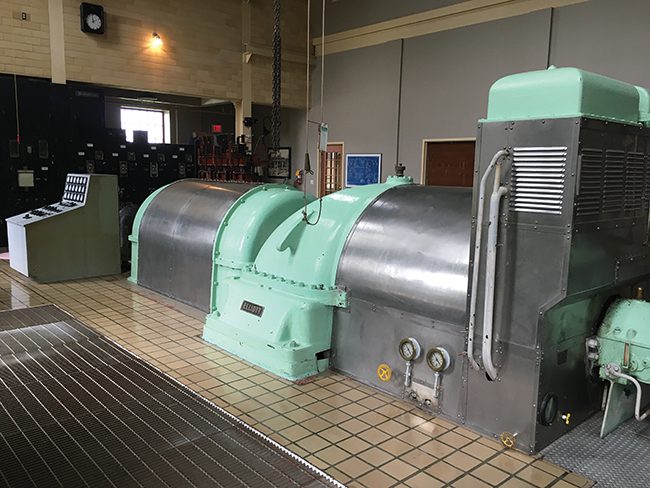New Life for Dead and Dying Coal Plants?

As coal plants are retired, power companies must decide what to do with sites. Some old plants have been added to the National Register of Historic Places and repurposed as commercial or office space, while other stations have utilized existing infrastructure for new solar or gas-fired plants. In the end, almost every situation has its own unique possibilities.
As coal-fired power plants shut down across the U.S., a decades-long trend that shows increasing velocity, a natural question arises: What to do with those now-useless hulks. Once a minor question, when coal-fired units often seemed immortal, the question has become far more serious.
| U.S Not Alone on Coal Plant Closings The U.S. is not the only country looking at closing a large number of coal-fired plants and wondering what to do with what's left. Chile is a high-income market economy as ranked by the World Bank. Wikipedia reports, The country is considered one of South America's most prosperous nations, leading the region in competitiveness, income per capita, globalization, economic freedom, and low perception of corruption." According to the news site Dialogo Chino, By 2040 Chile plans to close all coal-fired power plants. Now, experts are looking at how they can be used in the country's energy transition." Chile had an installed generating capacity of more than 26 GW at the end of 2020, with coal accounting for 20.3%, the largest share of the country's fossil capacity, followed by natural gas (18.9%) and petroleum-based capacity (11.3%). Hydro makes up most of the rest, some 26.7% of capacity, with solar (12.1%), wind (8.8%), biomass (1.8%), and geothermal (0.2%) furnishing the rest. Chile plans to close 11 of its 30 coal plants by 2024 and the remainder by 2040. As a result, writes Dialogo Chino, two additional challenges must be met: replacing Chile's energy currently produced by coal; and finding a use for the 30 plants that will be closed." The government and the companies involved are considering conversion to biomass or biogas, desalination plants, or to house new technologies such as Carnot batteries. In Europe, the largest electric utility, Enel, once heavily dependent on coal, says it will shut all its coal-fired capacity over the next six years, and repurpose the sites. Fabio Cautadella told the online publication Fast Company, Most of the coal-fired plants are being converted to renewable energy, but in some cases, they are enjoying a new lease on life with completely different roles." |
The U.S. Energy Information Administration estimates that 85% of power plant closures this year will be coal-fueled units, driven by the economics of natural gas and renewables, and the environmental politics of climate change (see sidebar U.S Not Alone on Coal Plant Closings"). S&P Global Market Intelligence predicts, U.S. coal-fired generating capacity is set to take a record plunge in 2028 in advance of tough environmental rules, with more than 23 GW scheduled to come offline, dwarfing the previous retirements record set in 2015."
What value remains in those derelict fossil units? Part of the answer is obvious: recycling and scrap. There is a lot of metal in those units, which can be salvaged for sale on scrap metal markets as the plants are decommissioned. Large pieces of equipment-such as switchgear and steam turbine generators-often can be salvaged.
It's About Real EstateBut there are less obvious and perhaps more valuable assets in the dead units: real estate. Legacy utilities and new entrepreneurs increasingly don't see just what's missing in a shuttered plant, but what could be. Not just bare land that can be converted into other power-generating opportunities, such as solar farms or gas units, or sites for new uses such as marijuana cultivation, but interesting architectural gems that can be turned into commercial and retail buildings.
A prime example is Baltimore's Pratt Street Power Plant in the heart of the city's main Inner Harbor business and tourist district. Originally a coal-fired plant generating power for the city's electric transit system and eventually part of the predecessor to the investor-owned Baltimore Gas and Electric system, the neo-classic plant closed in 1973.
 |
1. The Pratt Street Power Plant is a historic facility located in downtown Baltimore, Maryland. The plant closed in 1973 and has been repurposed as commercial space. Courtesy: Creative Commons / G. Edward Johnson |
After sitting vacant for years, the city and local businesses revived the stunning building early this century. Tenants have included a Hard Rock Cafe, Barnes & Noble, a contemporary art gallery, and the headquarters for The Cordish Companies, a large local real estate firm that has invested in casinos in the state (Figure 1). The building was listed on the National Register of Historic Places in 1987.
 |
2. The McPherson Board of Public Utilities repurposed the city's Power Plant No. 1 to create office space for the community-owned utility. The architects managed to retain some of the plant's history, such as the turbine generator, shown here, in a museum area of the building. Source: POWER |
Another example of residue real estate value from closed coal-fired plants is in McPherson, Kansas, a town of about 13,000 in the center of the state. McPherson's municipal utility featured a 1934 art deco coal-burning plant, later converted to oil, which closed in 1947. Converted to offices, it now houses the McPherson Board of Public Utilities. The building was listed on the National Register in 2007 (Figure 2).
There is more to repurposing shuttered fossil plants than rescuing architectural gems. A lot more (see sidebar A Nuclear Caveat").
| A Nuclear Caveat A caveat here. When talking about repurposing unneeded power plants, the discussion is about fossil units, particularly coal-fueled generators. Nuclear presents special, difficult circumstances, including lurking radiation and onsite spent fuel, that vastly complicate what can be done with surplus nukes. A federal agency, the U.S. Nuclear Regulatory Commission, approves and oversees the entire decommissioning process. |
A year ago, the U.S. non-profit energy think tank Institute for Energy Economics and Financial Analysis reported, Repurposing coal plants into solar and battery can pay up to 5 times more than decommissioning." The analysis concludes, For power utilities, repurposing coal plants offers many advantages.
First, repurposing reduces decommissioning costs because it avoids some of the environmental remediation requirements and allows partial re-use of existing assets such as the degraded land, as well as the generators, substations and grid connections. Second, it reduces the cost of commissioning greenfield renewable capacity at the same site. Third, for coal plants located in urban and semi-urban areas, repurposing manifests in multiple end uses leading to economic diversification and industrial rejuvenation, benefiting local economies and the workforce. Fourth, it could provide a lucrative exit strategy for stranded and stressed coal plants. And fifth, repurposing coal plant equipment (e.g. the turbo-generator) allows for retaining a part of the reactive power service for voltage control originally provided by the coal plant, a valuable service when rapidly adding renewable energy."
Repurposing is clearly a business opportunity. One of the earliest firms to get into turning dead plants into live opportunities is TRC, a firm headquartered in Windsor, Connecticut, which began operations through a connection with Travelers Insurance, and was incorporated in 1969 as The Research Corporation of New England. TRC describes its RE POWER" program as an integrated approach that manages the transition of end-of-life fossil fuel power plants from safe operational shut down, through decommissioning and asset recovery, to repurposing of the property to benefit the community and optimize your return on investment (ROI)."
TRC says its RE POWER process consists of three elements:
- Plant transitioning, involving strategic planning and recommendations for potential end use of property/electrical infrastructure, decommissioning and asset recovery strategies and pre-demolition planning activities."
- Decommissioning, including power plant decommissioning and demolition, site remediation and hazardous materials abatement and redevelopment planning."
- Repurposing/reuse, meaning redevelopment activities to allow for full use of the power plant site location, providing community benefit and/or enabling the sale of the asset for commercial purposes."
Recent projects include the 2017 removal of one of three large gas-fired units at the Los Angeles Department of Water and Power's Scattergood plant. This complex, 18-month project involved decommissioning the unit without disrupting the other two operating units. Repurposing consisted of replacing the conventional gas boiler with a combined cycle turbine and two simple cycle turbines.
In 2001, the Frontier Group of Companies, headquartered in Buffalo, New York, formed to bring together strategically aligned businesses with experience and capabilities in the area of large-scale industrial and commercial facility reuse, repurposing and redevelopment. The companies of the Frontier Group include industry leading operations for industrial demolition, industrial dismantling, asset recovery, equipment repurposing, industrial clean up, site remediation, brownfield redevelopment, facility acquisition, real estate development, energy exploration, energy production, and materials recycling." The Frontier Group says it is also developing multiple green energy facilities by transforming shuttered fossil fuel power plants into solar farms producing clean, green electricity."
In 2019, Frontier Group bought American Electric Power's shuttered five-unit Philip Sporn coal-fired plant in Mason County, West Virginia. Earlier this year, Frontier Group demolished the 450-MW Sporn Unit 5 (the other four units had nameplate capacities of 145-MW each). In a press release, Frontier CEO David Franjoine said, Since we acquired the former power plant, we have invested significant resources into repositioning this 280-acre brownfield site including preparing a plan to transform this brownfield into a modern industrial park," The site, he said, is near a recently announced Nucor steel plant, and has the necessary utilities and infrastructure to attract companies specializing in value-added steel, energy, material handling, and transportation logistics.
EPRI Advice to SellersFor utility companies with dead coal plants, or plans to euthanize current plants, the Electric Power Research Institute (EPRI) offers advice on how to think about these projects. In a 2019 report, A Comprehensive Approach to Repurposing Retired Coal Power Plant Sites: Transforming Liabilities to Assets," based on case studies, EPRI advances the concept of comprehensive repurposing." Its researchers wrote, Comprehensive repurposing may provide a new methodology for repurposing retired coal power plants. While environmental remediation is often a singular initial focus, comprehensive repurposing suggests a broader initial focus to more holistically and expeditiously identify challenges and sustainable solutions.
A key focus of comprehensive repurposing is bringing relevant parties together early in the process to holistically find solutions to complex problems. Accordingly, utility companies may find it beneficial initially to form an internal comprehensive repurposing task force composed of representatives of all relevant internal departments and possibly key external advisors (economic development officials, consultants, etc.). The task force's mandate might be to identify and implement market-driven candidate sites for repurposing."
-Kennedy Maizeis a veteran energy reporterand a frequent contributor to POWER.
The post New Life for Dead and Dying Coal Plants? appeared first on POWER Magazine.